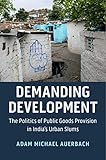Demanding Development : The Politics of Public Goods Provision in India's Urban Slums / Adam Michael Auerbach, American University, Washington DC.
Publisher: Cambridge, United Kingdom ; New York, NY, USA : Cambridge University Press, 2020Description: pages cmContent type:- text
- unmediated
- volume
- 9781108491938 (hardback : alk. paper)
- 9781108741330 (paperback : alk. paper)
- 307.30954 AUE 23
- HN690.Z9 M2625 2020
| Item type | Current library | Shelving location | Call number | Status | Date due | Barcode |
|---|---|---|---|---|---|---|
 BOOKs
BOOKs
|
National Law School | General Stacks | 307.30954 AUE (Browse shelf(Opens below)) | Available | 38455 |
Contents
List of Figures
List of Tables
Acknowledgments
1 Puzzling Disparities at the Margins of the City
1.1 The Puzzle of Uneven Public Goods Provision across Slum Settlements
1.2 Party Workers and Local Development
1.3 Urban Informality and the State
1.4 What Is a Slum?
1.5 Study Settings and Research Design
1.6 Organization of the Book
2 Setting the Stage: Governance and Political Parties in Urban India
2.1 India at Home in its Cities and Towns
2.2 The Proliferation of Urban Slums
2.3 Governance in the Post-Decentralization Indian City
2.4 Distributive Politics in India’s Slums
2.5 Party Organizations in Bhopal and Jaipur
2.6 Conclusion
3 How Party Worker Networks Impact Local Development
3.1 Competition, Connectivity, and Mobilizational Capacity
3.2 The Partisan Distribution of Party Workers
3.3 Why Party Worker Networks Vary across Settlements
3.4 Conclusion
4 India’s Slum Leaders
4.1 Demanding Development in India’s Slums
4.2 The Pervasiveness of Informal Leadership
4.3 The Construction of Informal Leadership
4.4 The Problem-Solving Activities of Slum Leaders
4.5 The Electoral Activities of Slum Leaders
4.6 Motivations to Engage in Slum Leadership
4.7 Slum Leaders as Party Workers
4.8 Conclusion
5 Views from the Ground: Historical Narratives from Eight Squatter Settlements
5.1 Jaipur Case Studies
5.2 Bhopal Case Studies
5.3 Comparative Observations
6 Party Workers and Public Goods Provision: Evidence from 111 Settlements
6.1 Survey Design and Data
6.2 Other Sources of Data
6.3 Variables and their Measurement
6.4 Statistical Models and Results
6.5 Causality and Historical Sequencing
6.6 Conclusion
7 Why Party Worker Networks Spread Unevenly Across Settlements
7.1 The Correlates of Party Worker Density and Party Representational Balance
7.2 Why are Some Settlements More Populous and Ethnically Diverse than Others?
7.3 Conclusion
8 Conclusion
8.1 Revisiting the Theory and Findings
8.2 Implications of the Book’s Findings
Appendix A Measuring Social Capital
Appendix B Additional Tables and Figures
Bibliography
Index

There are no comments on this title.